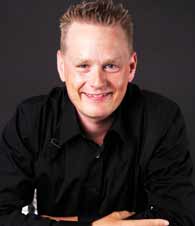So companies are trying to find the
triggers they have to pull in order to
make people feel comfortable about
spendingmoney. The best example of
that was Hyundai, which said you
can return your car within a year if
you lose your job and get a refund.
That’s a major change you will see in
marketing. And then you will see
companies start to build the very
functional, practical dimensions of
their brands. If you take Louis Vuitton
as an example, they will say, “In the
future, when you buy a Louis Vuitton
bag, it’s not just the most fashionable
bag on themarket, it also has a two-inone
dimension so you can turn it
inside out, and it’s red today and
black tomorrow. You can use the bag
both in the evening and the morning,
and you don’t have to buy a bag for
four years because it has two-color
dimensions to it.”
Also, companies will start to talk
about the past rather than the future.
We’re seeing that happening a lot
with brands now. They’re saying,
“Hey, if you talk about the past,
people feel safe.” For instance, I went
on a summer holiday, and it was a
disastrous holiday. The weather was
crap, the food was bad and the hotel
was bad. But when you look at the
photos from that holiday two years
later, you kind of forget all the bad
memories you had. That’s exactly
what’s happening in our minds.
Companies will start to push the past
more than the future, because we feel
kind of warm and soft for the past,
and trust the past a lot more. Because
brands are all about trust, they’re
going to push that dimension a lot
more.
That’s exactly what Louis Vuitton is
doing. Take any of the latest Louis
Vuitton ads they’re running right
now: They’re actually promoting
various actors who are not hot
anymore. They’re putting them in
settings which are fromthe 1960s, the
1950s, and basically you feel you are
buying the past.
You blew up $7 mn on the largest
neuromarketing research project in the world. And this project was
definitely the backbone of Buyology.
Kindly elaborate on this project.
I wanted to create a study that big,
that solid and that comprehensive
that its findings would be taken
serious by everyone – here are a few
words on the study: We decided to
employ two of the tens of
technologies or techniques available
to neuromarketing. Just like any
research field, there are a number of
approaches which neuromarketing
can make to any given hypothesis.
The unusual factor about Buyology
was that we used two technologies
from the raft of methods available to
us. Other neuro marketing studies
might have adopted just one. But we
employed two for the very simple
reason that the differing technologies
give us different windows, and
varying perspectives, from which the
same lines of inquiry can be
considered.
Neuroscientific methodologies give
accurate views on the brain, but
changing angles can alter the
interpretations that may be made of
that data. Buyology is the first
neuromarketing study to use two
rather than just one approach. This
increased the accuracy of results.
Functional Magnetic Resonance
Imaging (fMRI) was one of the two
technologies we used. fMRI is
considered to be the most
sophisticated brain-scanning
technology available. The machinery
works by using magnetic resonance
to detect and measure oxygen levels
in the blood stream. Higher oxygen
levels at certain places in the brain
indicate activity. This gives graphic
evidence of the parts of the brain
being activated by the given stimuli.
Because we know something of the
functions of the brain’s many regions,
neuroscientists are able to interpret
this activity. fMRI is 100% safe and
non-invasive. But it is very
expensive. It costs around $3,000-4,000 to scan each subject and this
amounts again to have the results
neuroscienti-fically interpreted. For
this reason, most studies before
Buyology have involved small sample
group – less than 30 people in each.
Buyology broke new ground by
scanning the brains of over 2,000
volunteers, across several countries,
and enabling the interpretation and
comparison of a substantial data bank
of results. There’s an ongoing
discussion between neuroscientists
about sample size. Some researchers
think a small sample size produces
valid results which is true,
depending on the aims of the
research. Other researchers favor a big
testing base. Buyology took both sides
of the argument into account by
involving 100 volunteers in the fMRI
testing, and 1900 in the SST work.
